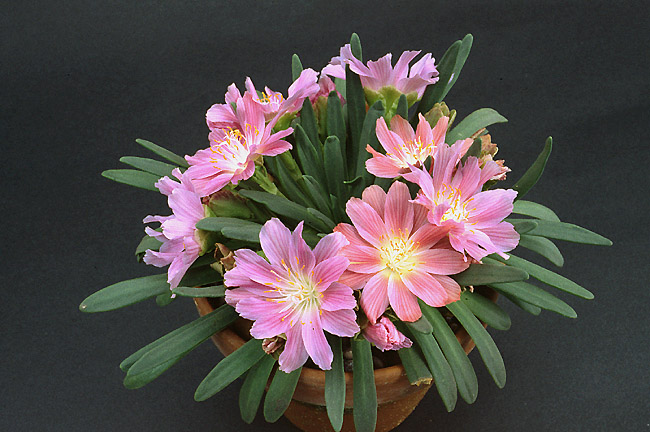|
Wisley's Alpine Log
By Paul Cumbleton
Log 5 28 February 2008
Lewisias
Repotting carries on apace. Last time Chris and the trainees were doing the Rhodohypoxis. Since then Meg has done her evergreen lewisias, again ably assisted by some of the trainees and volunteers. I thought in this log therefore I would concentrate on this genus, describing mainly the cultivation of Lewisia in pots (and certainly not attempt a review of the whole genus!!). I will add a few pictures to brighten up the text, but of course these are not currently in flower. However, I realised I have very few Lewisia pictures - and these are old slides. I have scanned these, but this didn't work out very well - for some reason my scanner is overexposing things and producing poor results. So the pictures this week are poor. I'm sorry for this, but I thought it would be better to show them anyway rather have a log with nothing but text!
There are six species of evergreen Lewisia and 13 species of deciduous types. The evergreen ones are:
L. cantelovii, L. columbiana, L. cotyledon, L. leeana, L. serrata and L. tweedyi.
Of these we grow four, with L. leeana and L. serrata being the missing ones.

Lewisia cotyledon
The deciduous types are:
L. brachycalyx, L. congdonii, L. disepala, L. keloggii, L. longipetala, L. maguirei, L. nevadensis,
L. oppositifolia, L. pygmaea, L. rediviva, L. sierrae, L. stebbinsii, L. triphylla.
Of these we grow just nevadensis, pygmaea, rediviva, congdonii and oppositifolia. It is probably worth saying that Lewisia disepala, kellogii, maguirei and triphylla are very rare in cultivation and triphylla is also difficult to grow and flower. L. leeana needs particular care with watering. All species are native to the western side of the USA.

Lewisia rediviva
Basic Cultivation
1. Evergreen types
Growing season: Approximately late February to late September
Compost: They prefer a neutral to acidic mix. We use 2 parts John Innes, 1 part peat, 1 part perlite (or grit or a mix of the two).
Repotting: We do it in late February, though seedlings are best potted on 2 or 3 times during their first growing season so they never get a check from being root bound.
Watering: Keep just moist from October to late February (this is their dormant period though they retain their leaves while dormant). Start to increase water from late February (the centre of the rosette often turns a brighter, shinier green when growth recommences and this can be used as a guide as to when to repot and to start increasing the watering). Water normally through the growing season and reduce to keep just moist again by the end of September. During very hot weather watering should be reduced to a bare minimum (the succulent leaves keep the plant going and they are not expecting rain in hot periods. Keep them too wet at such times and they will rot). Try to keep water out of the centre of the rosettes to prevent rotting.
Feeding: Give an occasional liquid feed (e.g. Phostrogen) whilst in active growth
Light: Prefer a partially shaded position

Lewisia tweedyi

Lewisia tweedyi alba
2. Deciduous types
Growing season: Approximately October to June
Compost: We use a simple 50/50 mix of John Innes and grit (or perlite or a mix of the two)
Repotting: Best done in autumn just before or just as they come into growth, though can be done any time during dormancy as long as the compost used is not wet.
Watering: We start in autumn, about October - but they usually tell you when by producing a tuft of new growth, even if they are bone dry while dormant. Keep moist but not wet throughout winter. Water normally as growth rate increases in spring and reduce in early summer as they start to go dormant. Keep dry whilst dormant (particularly L. rediviva) though perhaps not absolutely bone dry - though they usually tolerate this.
Feeding: I think they benefit from an occasional liquid feed (e.g. Phostrogen) whilst in active growth, but don't overdo it or they end up looking like cabbages on a bad hair day!
Light: Prefer full sunlight

Lewisia rediviva 2

Lewisia cotyledon x rediviva
Lewisias are one of those "great value for money" plants - many are easy to grow, relatively pest free (except for the odd aphid) and can bloom over a very long period. Some regard the L. cotyledon hybrids as too bright and gaudy - as for me, I love them for giving a huge splash of colour. Just the ticket for lifting a dull spirit any day!

Lewisia display
^ back to the top ^
|

